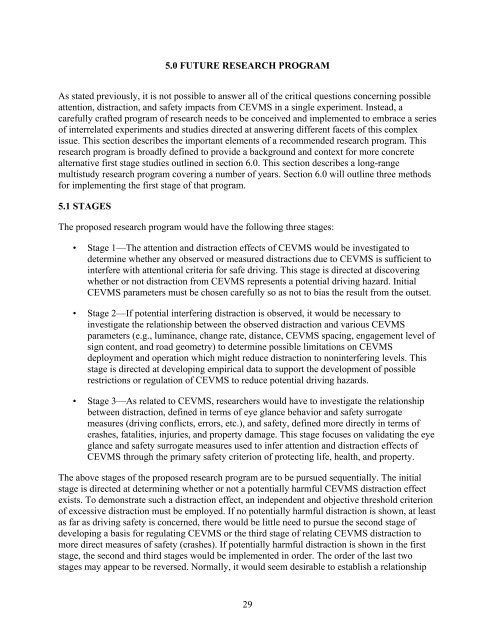The Effects of Commercial Electronic Variable Message Signs ...
The Effects of Commercial Electronic Variable Message Signs ...
The Effects of Commercial Electronic Variable Message Signs ...
Create successful ePaper yourself
Turn your PDF publications into a flip-book with our unique Google optimized e-Paper software.
5.0 FUTURE RESEARCH PROGRAM<br />
As stated previously, it is not possible to answer all <strong>of</strong> the critical questions concerning possible<br />
attention, distraction, and safety impacts from CEVMS in a single experiment. Instead, a<br />
carefully crafted program <strong>of</strong> research needs to be conceived and implemented to embrace a series<br />
<strong>of</strong> interrelated experiments and studies directed at answering different facets <strong>of</strong> this complex<br />
issue. This section describes the important elements <strong>of</strong> a recommended research program. This<br />
research program is broadly defined to provide a background and context for more concrete<br />
alternative first stage studies outlined in section 6.0. This section describes a long-range<br />
multistudy research program covering a number <strong>of</strong> years. Section 6.0 will outline three methods<br />
for implementing the first stage <strong>of</strong> that program.<br />
5.1 STAGES<br />
<strong>The</strong> proposed research program would have the following three stages:<br />
• Stage 1—<strong>The</strong> attention and distraction effects <strong>of</strong> CEVMS would be investigated to<br />
determine whether any observed or measured distractions due to CEVMS is sufficient to<br />
interfere with attentional criteria for safe driving. This stage is directed at discovering<br />
whether or not distraction from CEVMS represents a potential driving hazard. Initial<br />
CEVMS parameters must be chosen carefully so as not to bias the result from the outset.<br />
• Stage 2—If potential interfering distraction is observed, it would be necessary to<br />
investigate the relationship between the observed distraction and various CEVMS<br />
parameters (e.g., luminance, change rate, distance, CEVMS spacing, engagement level <strong>of</strong><br />
sign content, and road geometry) to determine possible limitations on CEVMS<br />
deployment and operation which might reduce distraction to noninterfering levels. This<br />
stage is directed at developing empirical data to support the development <strong>of</strong> possible<br />
restrictions or regulation <strong>of</strong> CEVMS to reduce potential driving hazards.<br />
• Stage 3—As related to CEVMS, researchers would have to investigate the relationship<br />
between distraction, defined in terms <strong>of</strong> eye glance behavior and safety surrogate<br />
measures (driving conflicts, errors, etc.), and safety, defined more directly in terms <strong>of</strong><br />
crashes, fatalities, injuries, and property damage. This stage focuses on validating the eye<br />
glance and safety surrogate measures used to infer attention and distraction effects <strong>of</strong><br />
CEVMS through the primary safety criterion <strong>of</strong> protecting life, health, and property.<br />
<strong>The</strong> above stages <strong>of</strong> the proposed research program are to be pursued sequentially. <strong>The</strong> initial<br />
stage is directed at determining whether or not a potentially harmful CEVMS distraction effect<br />
exists. To demonstrate such a distraction effect, an independent and objective threshold criterion<br />
<strong>of</strong> excessive distraction must be employed. If no potentially harmful distraction is shown, at least<br />
as far as driving safety is concerned, there would be little need to pursue the second stage <strong>of</strong><br />
developing a basis for regulating CEVMS or the third stage <strong>of</strong> relating CEVMS distraction to<br />
more direct measures <strong>of</strong> safety (crashes). If potentially harmful distraction is shown in the first<br />
stage, the second and third stages would be implemented in order. <strong>The</strong> order <strong>of</strong> the last two<br />
stages may appear to be reversed. Normally, it would seem desirable to establish a relationship<br />
29

















